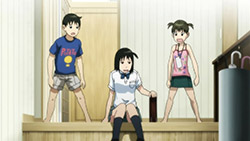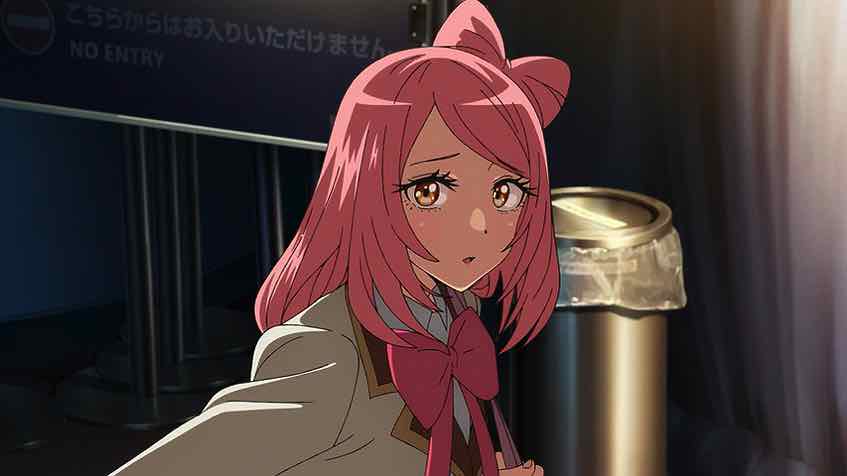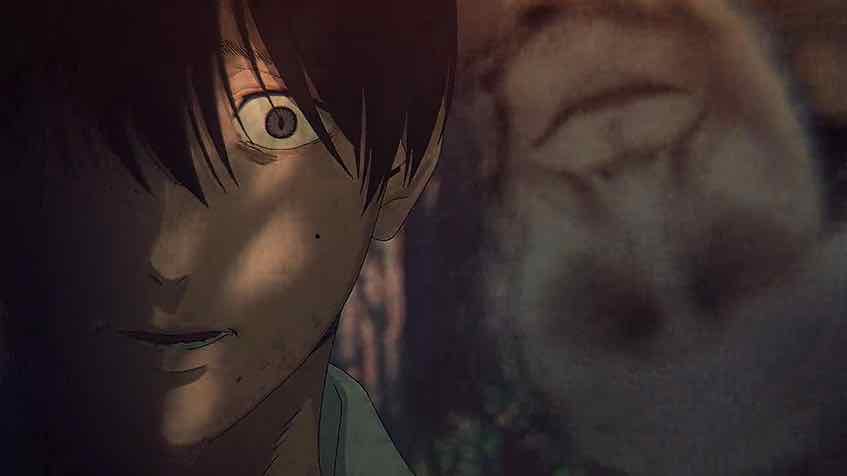 |
| At long last – Mr. Poorman! |
It would be pretty hard to capture in words why this episode of Soredemo was so great, but it’s obvious enough when you watch it. In hindsight, this property was a perfect fit for Shinbo and SHAFT – the comedic style is in sync with the SHAFT sensibility of quick cuts and random absurdities.
For starters, the long-awaited debut of the “Mr. Poorman” manga omakes arrived. It’s not that the jokes in these 4-koma are so hilarious in and of themselves, but the pure randomness of the gags and how delightfully politically incorrect they are. They make a nice change from the Josephine observations – but as Josephine loses her spot on the eyecatches she’s making her way into the skits themselves. As if we didn’t already have enough great supporting characters we get introduced to the Arashiyama Dad this week, through his early morning walk with Josephine. Not much goes right for either father or daughter this week, and you get the sense that it’s not unusual for the poor guy – Josephine has him ranked as the only human below her on the family totem pole.
The entire episode took the form of short, hilarious intercuts into the lives of the characters this week. Starting and finishing with Hotori and Futaba at the beach, we got another excellent segment with the hapless math teacher trying to pound some sense into Horoti in one-on-one remedial class time (with no luck, naturally). We also got a couple of dream sequences from Hotori, both involving Josephine. After RL Futaba mocked her as looking like a raccoon, Hotori dreams Josephine packs up and heads off to the mountains to be with her own kind. And after Futaba turns up the heat on a sleeping Arashiyama (who had snuck into her apartment, cranked the A/C and left the cat outside in the heat) Hotori dreams herself in a sort of Hare Guu jungle setting where a pack of Josephines accidentally set fire to “Mt. PomPom”.
With all the good stuff this week probably the best was the interaction between Hotori and Futaba. Starting with their snarky greeting on the street (“Aho-tori and Futa-baka”) and later in Futaba’s apartment and finally concluding on the beach, these two have developed a delightful chemistry. They bicker and snipe at each other and Futaba is clearly the one person who can scare Hotori off one of her manic tirades, but there’s clearly an “opposites attract” kind of bond between them. It says something about how deep the stable of characters on the show is – and how well SHAFT has developed them – that we can go almost an entire episode without visiting Seaside and have almost no Sanada, Tatsunmo and Grandma and not miss them. Though they did make an appearance at the end – Sanada and Tatsuno still utterly hapless and clueless in their love triangle with Hotori, Grandma still bemused and disgusted by their inability to communicate with each other.
 |
| Jungle Wa Hortori |
We hear “slice-of-life” used quite a bit and in many different contexts, but I think this manga/anime is about as close to pure slice-of-life as you can get. There’s not really much overriding plot here – just establishing characters and watching them interact in humorous and sometimes wistfully emotional ways. This style suits SHAFT remarkably well – as it did in Natsu no Arashi, though that series had significantly more focus on an overriding plot than this one does. I’ve always felt that Shinbo does better with small concepts than big ideas – the nature of his directing style is a sort of ADD/HD St. Vitus Dance, and he seems to struggle when trying to keep focus on continuity and big plot arcs. Here, he can shift quickly through his sight gags and wistful observations and it serves the original manga well. There’s been some talk of a second season and we know SHAFT loves sequels, so there’s hope that this will continue. I hope so – there’s lots more material to cover and no sign whatsoever that the series is losing its mojo.




